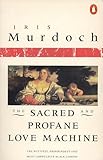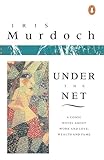








This year I almost exclusively read Iris Murdoch novels. I read, in no particular order: The Sea the Sea, The Bell, The Sacred and Profane Love Machine, A Fairly Honourable Defeat, The Red and the Green, The Nice and the Good, and A Word Child (only seven, for I am a slow reader, and Murdoch’s books are long and dense). These after a stretch in late 2021 when I read The Black Prince, Under the Net, and A Severed Head. But 2022 saw me fully, consciously, and gratefully accepting my status as Iris-pilled.


 (I can count on one hand the non-Murdoch books I read: Nabokov’s Pnin, Don Carpenter’s Hard Rain Falling, Isaac Butler’s The Method, and that might be it.)
(I can count on one hand the non-Murdoch books I read: Nabokov’s Pnin, Don Carpenter’s Hard Rain Falling, Isaac Butler’s The Method, and that might be it.)
To say I’m Iris-pilled is to say not only that I love her work, and not only that I am working my way sedulously through her 26-novel corpus, but that I rarely want to read anyone but her. It’s a kind of readerly obsessiveness I have not experienced since my completist teens with Kurt Vonnegut and Douglas Adams. Further, as a congenital non-collector, I have decided to collect all of her novels in hardcover. And so my year in reading has not only been spending most of my time with a single author, but also wondering what it is about her work that makes me uninterested in other authors. I find myself a bit like a previously carefree bachelor who has fallen love and craves monogamy.
Other Iris-lovers out there will know what I mean: what is it about her? There is a peculiar flavor to her work almost completely distinct from any other writer. It is not, I don’t think, a question of style, although she is a very good, often great, stylist. Her style is distinct and identifiable, but it not the primary distinguishing feature of her work as opposed to many other first-rank twentieth century authors: Roth, Morrison, Woolf, etc. I think it has more to do with her idiosyncratic plot structures. A standard novel—to simplify drastically—proceeds something like this: the main character finds the stasis of their lives disturbed, they act or do not act to address this situation, and their action/inaction creates a chain of consequence that proceeds through the book, by the end of which we understand how they have changed, or not. Iris Murdoch novels are noteworthy, on the other hand, for their general lack of inciting incident, and it usually isn’t even clear until around the mid-point of a Murdoch novel what the main problem or conflict of the book is.
On paper, this sounds like it would be awful, but it works and works beautifully. What she is doing in the first half of her novels amounts to an extraordinarily careful table-setting of character relationships: attractions, repulsions, grudges, fondnesses, affairs past and present, simmering arguments, mutual indebtedness, unresolved questions and intrigue, and always an ambient horniness. Her novels typically feature a large cast of characters, whom we get to know intimately, and whose private dramas provide the forward motion of the book for the first one to two hundred pages. When the main drama crystallizes—and this drama is at times surprising, unforeseeable within the story to that point—it is like a large domino falling, causing all the other carefully placed dominos to tumble in every direction. This storytelling mode somehow manages a kind of cozy pleasure in the first half’s exposition and a gripping, at times terrifying drama in the second half’s denouement.
I think what makes this work—perhaps the reason Murdoch was capable of writing novels this way—is her preternatural sensitivity to character temperament and personality, especially along a moral axis. More than any other author I can think of, Iris Murdoch is concerned with the moral behavior of her characters, with the choices they make and why they make them. There is always an intense human drama about the actions and thoughts and feelings of even the most ancillary characters in her work. This fascination with the moral life—what it means to be good, whether that’s even possible, the difference between thought and deed—powers her work and provides it a depth that sometimes feels quite lacking when one strays briefly from Murdochia. Very few other authors—I want to say perhaps none besides Shakespeare—manage such sustained interest in the souls of their characters.
Murdoch shares another notable affinity with The Bard, namely in the way her work recycles the same large cast of characters (h/t Isaac Butler for pointing this out in his excellent appearance on my Fan’s Notes podcast). One runs into the same characters over and again, as Murdoch shuffles these types and lays them down like cards in a tarot deck: The Sexy Mother Figure Who Draws Everyone Toward Her; The Man Who Feels Past Love, Yet Is Nonetheless Drawn to the Sexy Mother Figure; The Mystic/Seer in the Attic; The Unknowable Pagan Figure of Havoc and Rearrangement (often, regrettably, Jewish); The Adolescent Burning with Desire and Resentment; The Older Man Transfigured By Unexpected Love; The Perhaps Too Faithful Husband; The Very Unfaithful Husband; The Unpredictable Boyish Girl (a Manic Pixie Dream Girl prototype); The Good Dog; etc.
Part of understanding Iris Murdoch’s project is seeing her rework these archetypes, fitting them together in different configurations that produce vastly different effects. The attic mystic in The Red and the Green, the dissolute and cowardly Barnabas, reappears in A Fairly Honourable Defeat, as the righteous though slovenly Tallis Browne; The Sea, The Sea’s Charles Arrowby reimagines The Black Prince’s older man transfigured by love, Bradley Pearson, as an even older, more transfigured (and possibly deranged) man. And she not only continuously shuffles character types, she shuffles moral philosophies as well, putting good philosophy in the mouth of unpleasant characters and having some of her most likable characters spout nonsense. In The Bell, for instance, the closest thing to Murdoch’s personal philosophy is held by the eminently sympathetic Michael Meade, who also happens to be a pedophile, and whose philosophical self-justification ultimately destroys the novel’s peaceable kingdom.
In this sense, her work repays an extended sojourn in a way that other writers’ work simply cannot. A good novel teaches you how to read it; each one of Murdoch’s novels teach you how to read all the other ones. And so, to fully read Iris Murdoch demands, for a time, fully living in her world.
The post A Year in Reading: Adam O’Fallon Price appeared first on The Millions.














